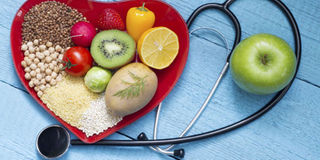Eat right, live a long healthy life

What you need to know:
- Book Review. Gillian Nantume reviews Dr Paul Kasenene’s book Eat Your Way To Wellness which loads you up with tips on how feeding right affords you a healthy life.
Have you always struggled with choosing the right food to eat and weight loss? Well, your food confusion might be at an end, what with a new book that promises seven principles that will help you achieve your optimal health and ideal weight. If you are one of those people who are interested in being healthy and eating healthier food, then Eat Your Way to Wellness, a book by Dr Paul Kasenene, who has 10 years’ experience in nutrition, is right up your cart.
Overfed, yet undernourished
As we shift more away from traditional foods to the processed foods, the most common substance we consume in our foods is refined sugar, which we find in everything between soda, doughnuts and cakes. Also, the empty calories in refined foods, such as fast food, have also ensured that overweight and obesity have become a challenge to Ugandan society.
Fast food tastes good but is addictive. While many educated people know the dangers in processed foods, it takes time for one to wean themselves off these foods. The author paints a grim picture of the amount of refined sugar and fast foods consumed nowadays in Africa. “What do you think happens to the fried chips and sausages that someone eats and that margarine innocently spread on a slice of refined white bread? Where does your food end up? It doesn’t just pass out of your system; a good proportion becomes a part of every bodily cell. Eat healthily and you create a healthy body, but if you eat junk … you complete that sentence … If you want to be physically well, eat to offer your body the best building blocks.”
Healthy food can be enjoyable
There is happiness and comfort in fast foods. So, I know what you are thinking – how can one eat greens every day like a goat? How can one adapt to boiled food at every meal and snack on only fruits. The author writes, “Half of the food on your plate should consist of the micronutrient-rich non-starchy vegetables or fruit … A quarter of the food should consist of beans and legumes and all types of nuts … A quarter of the food on your plate should consist of grains and/or starchy vegetables (potatoes, yams, pumpkins, cassava, plantains, matooke), for example, the carbohydrate-rich foods.
We have heard of people completely eliminating carbs from their diets in order to lose or maintain weight because these foods are calorie-dense. Dr Kasenene cautions that carbohydrates – which include maize, millet, rice, sorghum, oats, and barley – must not be eliminated because they are the primary energy fuel source in our food.
“The body needs carbohydrates to generate the energy used to move, to function, and to stay alive. In fact, the nutrient the body needs most is carbohydrates … However, eat only minimal to moderate amounts of starchy foods and in their whole, unrefined, and natural state.”
Take out your calculator
Many articles have been written about plant-based and animal-based diets. However, where is the balance? How much of these two diets should you combine in your everyday meal? The author advised that all animal foods, including meat, poultry, fish, eggs, and dairy products should comprise no more than five per cent of your total food: the smaller the quantity the better.
On the other hand, he emphasises that plant foods – which include non-starchy vegetables, fruits, beans and other legumes, nuts and seeds and small amounts of healthy oils – should comprise 95 per cent of your food. Water underscores any diet, so as you seek to change your eating habits, drink plenty of water throughout the day.





